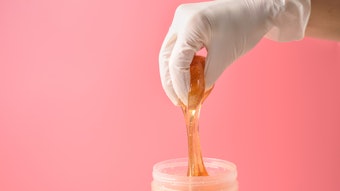
The feet are perhaps the hardest-working and most neglected area of the body. The foot itself is a sophisticated piece of anatomical architecture. It is literally the body’s support and foundation, yet most often do nothing more for their feet than slick some colorful polish over the toenails during sandal season. Feet deserve and need more than just cosmetic prettifying. In fact, educating yourself as a skin care professional, and then educating your clients to care for their own feet, benefits the individual’s head–to–toe health.
Pedal extremities
Adding therapeutic, refreshing and energizing foot services to your skin care facility’s menu can provide a new holistic dimension to your revenue. Add a marketing spin by introducing a new Holiday Shopper’s Foot Treatment as a respite from those long days scouring the mall; tie in with your city’s charity walks and marathons; or just strike a chord with stiletto-wearing fashionistas by featuring the High Heel Helper as a menu item especially created for the style-conscious.
Foot treatments are always popular, with the massage step being the most pleasurable part of any pedicure. Beyond the feel-good factor, why the feet? They may seem less intimate than the face or trunk area of the body, and people, in general, are less intimidated by having them worked on. Of course, you will need to assess your client’s ticklish level, but feet can be sweet.
The physical foot: Fragile strength
Why do your feet hurt at the end of a long day? For one thing, feet are bony: A pair of human feet contains 52 bones, many of which are prone to breakage, making up approximately 25% of the total number of bones in the entire body. Each foot is supported by 33 joints, 107 ligaments, and 19 muscles and tendons. Feet are extremely sensitive and receptive to touch, due to the wealth of nerve-endings present. Also, because many keep their feet covered and protected most of the time, they may be more sensitive than the hands, which are similarly constructed. And, as is true of any machine with many moving parts, a lot can go wrong mechanically.
As people age, their feet are simply more prone to degeneration. Apart from trauma, such as breaks and tears, simple wear from the passage of time may cause pain in the feet. A common source is plantar fasciitis, which is a painful inflammation of the connective tissue on the sole of the foot. This condition is common among people who stand for long periods of time each day, which is why it is known as policemen’s heel—but anyone who stands on a concrete floor for eight hours a day is at risk. It is also common among aging weekend warriors, such as tennis players and runners, especially if they are overweight.
Shoes also often create drama for the under-appreciated foot. Of course, the narrow pointed toe and high heel of the coveted Louboutins and Jimmy Choos can crush toes, create corns and bunions, and cause painful, long-term muscular shortening. Flip-flops are frowned upon by orthopedists, because they offer the foot no support. And even sensible closed-toe shoes, including the ubiquitous sheepskin boots, may invite toe fungus if the feet frequently get sweaty during the day.
Many other issues may threaten the well-being of the feet, affecting the overall well-being of the person. Foot treatments given in skin care facilities must not address serious medical conditions, but instead should be positioned as part of overall wellness, well-being and a source of therapeutic touch.
The metaphysical foot
In the modern industrial world, feet tend to be viewed as dirty and somehow less than noble. This was not the case in the ancient world, including classical Egypt, Greece and China, where foot-bathing and foot-anointing had a sacred element.
Throughout Asia, enlightenment is symbolized by the iconic footprint of Buddha. Not coincidentally, the word dharma often translates to mean “path,” a key concept in Buddhist practice that often discusses the steps and footprints of Siddartha, the founder of Buddhism. In many ancient healing systems, including ayurveda, an understanding of the feet was considered essential to understanding and treating the overall health of the individual. This led to the current concept used in reflexology that every zone of the feet, as well as hands, corresponds to an internal organ, system or area of the body. By applying pressure to the appropriate area or point along a meridian, inner imbalances may be corrected for improved function and health.
Today, reflexologists reference a very complex map of the soles of the feet, where each area of the foot corresponds to organs and systems. Many with a specifically Taoist focus believe that contact with these areas alters the flow of the concept of life energy, qi or chi, and thus can prevent illness and support healing. Even more traditional Chinese beliefs assign esoteric meanings to the length of the toes and more.
The West weighs in
Not all Western professionals acknowledge reflexology as viable. However, here’s the good news: More conventional medical environments are taking an interest in the role and benefits of reflexology, and massage in general. This is thanks, in part, to the recognition and integration of complimentary alternative medicine (CAM) in many major hospitals, as well as consumer demand and the hard clinical data now available via fantastic web portals, such as www.spaevidence.com.
The Ultimate Foot-saver Treatment
Begin The Ultimate Foot-saver Treatment (See Treatment How-to: The Ultimate Foot-saver Treatment) with a traditional signed consultation, and analysis of the feet. Apply the same scrutiny as you do when examining your client’s face and other areas for any indicators of medical issues or possible contraindications to the feet. Remember, it’s not within your role to diagnose illness or treat disease—leave that to medical professionals. Following are some interesting observations you can apply that combine Eastern and Western disciplines.
- Pinch the toes to be sure that the color snaps back instantly. Inadequate blood flow may cause tingling, numbness, cramping, and discoloration of the skin and toenails. Cold feet and toes may indicate circulatory problem sometimes linked to smoking, high blood pressure or heart disease.
- Swollen feet may signal poor lymphatic drainage. Feet that are continually swollen can be a sign of more serious health conditions with the lymphatic or endocrine system.
- Check the toenails for rippling, thickening, sponginess and discoloration. These signs may indicate a past of continuous trauma to the nail bed, including pressure from ill-fitting shoes, damage from gel polish or pigment absorption from darker nail polishes. Lifting of the nail plate and yellow or white discoloration may indicate a possible fungal infection. The infection starts at the nail fold and resides in the nail bed, making it hard to treat. Shoes that fit poorly may make the infection worse or, in some cases, even cause the infection. Topical and oral medications must be prescribed by a physician, but some laser treatments have shown positive results.
- Check for topical fungal infections elsewhere on the foot, especially between the toes. Itchy, scaly skin may be athlete’s foot, which is easy to pick up in gym showers. Food allergies, or a reaction to chemicals or certain products can result in contact dermatitis, which also may cause itching, redness, blisters and dry patches. Moles between the toes should also be documented. Sunny flip-flop friendly climates in particular report higher rates of melanoma on the feet. Ensure your client is also applying an SPF in this area.
Health and hygiene
Whether you are a nail tech performing a traditional pedicure, a skin care professional giving a spa foot treatment or a trained reflexologist, you must always legally abide with state health and hygiene codes. Regulations can differ state-to-state and license-to-license regarding what you can do and where you can touch. What needs to remain consistent is the level of professionalism that applies to esthetic work and conduct. Recently, pedicures specifically have received some terrifically bad public relations coverage due to poor hygiene, unsafe practices and the resulting horror stories where clients have contracted staph infections and other infectious diseases.
Remember to treat feet with the same respect given to the face and body. This means no low-end, bargain-bin products filled with common irritants, such as artificial fragrances or colors—especially important to remember, because artificially fragranced foot products with heavy fruity aromas sometimes sway clients to use them. Also, be judicious when planning a treatment. Even if you can legally remove dead skin with a blade or use fish to munch it away, re-think whether you have the client’s health and best interests in mind. Skin care professionals have fought long and hard to be respected, so let’s not throw it out with the foot soak.











